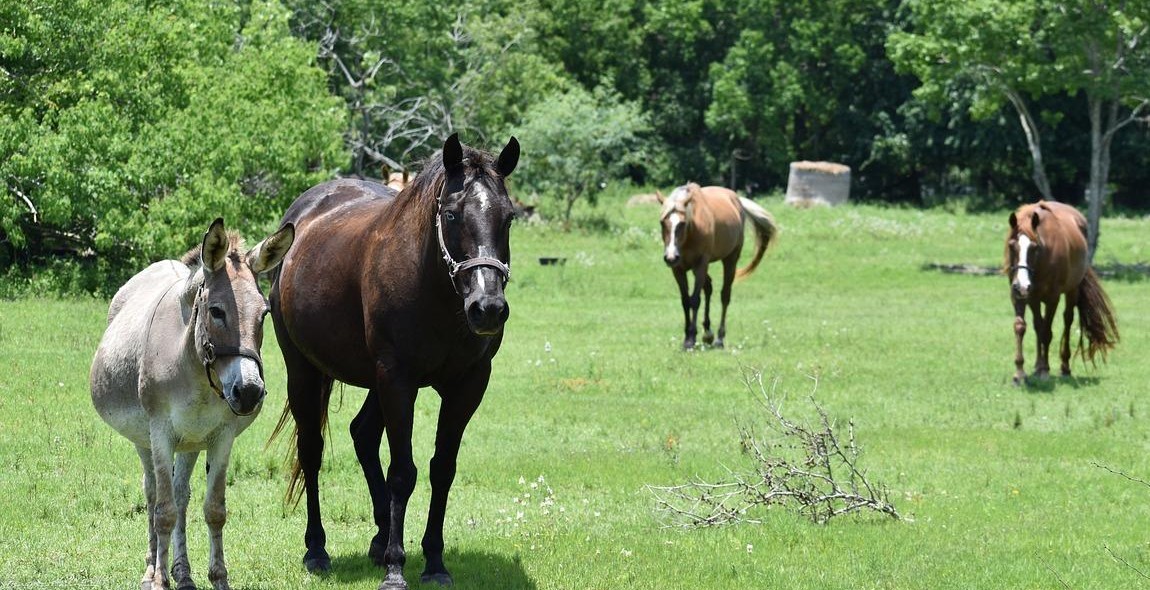How to Crossbreed Mules: Selecting Compatible Horse and Donkey Breeds
As an experienced animal breeder, I have always been fascinated by the process of creating new and unique breeds. One of the most intriguing crossbreeds that I have worked with is the mule – a hybrid animal that is the result of breeding a male donkey with a female horse. While mules are sterile, they are highly valued for their strength, intelligence, and endurance.
If you are interested in crossbreeding mules, it is important to understand the process and select compatible horse and donkey breeds. In this article, I will share my personal experience and offer tips on how to successfully crossbreed mules.
The Importance of Selecting Compatible Breeds
When it comes to crossbreeding mules, selecting compatible horse and donkey breeds is crucial. The horse and donkey must be of similar size and temperament, and they should have similar physical characteristics. This will increase the likelihood of producing a healthy and strong mule.
Factors to Consider When Selecting Horse and Donkey Breeds
There are several factors to consider when selecting horse and donkey breeds for crossbreeding. These include:
- Size and weight
- Temperament
- Physical characteristics
- Fertility
By carefully considering these factors and selecting compatible breeds, you can increase your chances of producing a healthy and strong mule.
| Horse Breed | Donkey Breed |
|---|---|
| Quarter Horse | Miniature Donkey |
| Thoroughbred | Standard Donkey |
| Arabian | Mammoth Donkey |

What is a Mule?
A mule is a hybrid animal that is created by crossbreeding a male donkey with a female horse. The genetic makeup of a mule is unique, as it inherits half of its genetic material from each of its parents. Due to this, mules have distinct physical characteristics that differentiate them from their parent breeds.
Genetic Makeup of a Mule
Mules have 63 chromosomes, which is an odd number. This is because donkeys have 62 chromosomes, while horses have 64 chromosomes. The genetic makeup of a mule results in a hybrid animal that is stronger and hardier than its parent breeds. Mules are also known for their intelligence, endurance, and sure-footedness.
Physical Characteristics of a Mule
Mules have distinct physical characteristics that set them apart from their parent breeds. They are typically larger than donkeys, with a height ranging from 12 to 17 hands. They have long ears, like donkeys, and a short mane and tail, like horses. Mules also have a unique braying sound that is a combination of the neigh of a horse and the bray of a donkey.
Mules are known for their strength, and they can carry heavy loads and pull carts and wagons. They are also used in agriculture and forestry, where their endurance and sure-footedness make them ideal for working in rough terrain.
| Physical Characteristics | Donkey | Horse | Mule |
|---|---|---|---|
| Height | 9-14 hands | 14-18 hands | 12-17 hands |
| Ears | Long and pointed | Short and rounded | Long and pointed |
| Mane and Tail | Short and coarse | Long and flowing | Short and coarse |
In conclusion, mules are a unique hybrid animal that is created by crossbreeding a male donkey with a female horse. Their genetic makeup and physical characteristics set them apart from their parent breeds, and make them ideal for working in agriculture and forestry. Mules are strong, intelligent, and sure-footed, and are highly valued for their endurance and versatility.

Selecting Horse and Donkey Breeds for Crossbreeding
When it comes to crossbreeding mules, selecting the right combination of horse and donkey breeds is crucial. Not all horse and donkey breeds are compatible, and the offspring may not have the desired traits or characteristics. Here are some things to consider when selecting horse and donkey breeds for crossbreeding:
Characteristics of a Good Donkey Breed
Donkeys are known for their hardiness, intelligence, and calm temperament. When choosing a donkey breed for crossbreeding, look for the following characteristics:
- Size: Donkeys come in different sizes, from miniature to standard. Choose a size that is compatible with the horse breed you plan to use.
- Conformation: Look for a donkey with a straight back, good bone structure, and strong legs.
- Temperament: Donkeys are known for their calm and steady temperament. Choose a donkey that is easy to handle and not easily spooked.
- Color: Donkeys come in different colors, from gray to brown to black. Choose a color that complements the horse breed you plan to use.
Characteristics of a Good Horse Breed
Horses come in different breeds and have different traits and characteristics. When choosing a horse breed for crossbreeding, look for the following characteristics:
- Size: Horses come in different sizes, from pony to draft. Choose a size that is compatible with the donkey breed you plan to use.
- Conformation: Look for a horse with good conformation, strong legs, and a straight back.
- Temperament: Choose a horse with a calm and gentle temperament that is easy to handle.
- Color: Horses come in different colors, from chestnut to black to gray. Choose a color that complements the donkey breed you plan to use.
Compatibility
When selecting horse and donkey breeds for crossbreeding, it is important to choose breeds that are compatible. The offspring should have the desired traits and characteristics, such as size, conformation, temperament, and color. Some popular horse and donkey crossbreeds include:
| Horse Breed | Donkey Breed | Offspring |
|---|---|---|
| Thoroughbred | Mammoth Jack | Mule |
| Quarter Horse | Miniature Donkey | Hinny |
| Arabian | Standard Donkey | Mule |
When selecting horse and donkey breeds for crossbreeding, it is important to do your research and choose breeds that are known to produce healthy and desirable offspring. With the right combination of horse and donkey breeds, you can produce mules and hinnies with the desired traits and characteristics.
Crossbreeding Process
Mating the Donkey and Horse
The first step in the crossbreeding process is to select a compatible horse and donkey breed. It is important to choose a mare that is in good health and has a gentle temperament. The stallion should also be in good health and have a good temperament. Similarly, the donkey should be a healthy and gentle jack. It is important to note that not all horse and donkey breeds are compatible for crossbreeding. It is advisable to consult with a veterinarian or animal breeding expert before embarking on the crossbreeding process.
Once the compatible breeds have been selected, the mating process can begin. The mare should be in heat, and the jack should be brought in to mate with her. The mating process can take anywhere from a few minutes to an hour. It is important to monitor the mating process to ensure that it is successful. If the mating is not successful, it may be necessary to repeat the process.
Gestation and Birth of the Mule
After a successful mating, the mare will carry the mule for approximately 12 months. The gestation period for a mule is longer than that of a horse or a donkey. During this time, it is important to monitor the mare’s health and provide her with proper nutrition and care.
When the mule is ready to be born, the mare will go into labor. The birth process for a mule is similar to that of a horse or a donkey. It is important to monitor the birth process to ensure that it is successful. If there are any complications, it may be necessary to call a veterinarian.
Once the mule is born, it should be examined by a veterinarian to ensure that it is healthy. Mules are generally healthy and robust animals, but it is important to provide them with proper nutrition and care to ensure their well-being.
| 1. | Choose compatible horse and donkey breeds |
| 2. | Monitor the mating process |
| 3. | Monitor the mare’s health during gestation |
| 4. | Monitor the birth process |
| 5. | Examine the mule after birth |
In conclusion, the crossbreeding process for mules involves selecting compatible horse and donkey breeds, monitoring the mating process, monitoring the mare’s health during gestation, monitoring the birth process, and examining the mule after birth. With proper care and attention, mules can be healthy and robust animals that make excellent work and riding companions.

Conclusion
Crossbreeding mules can be a challenging but rewarding experience for any horse or donkey breeder. The process requires careful selection of compatible breeds and proper breeding techniques to ensure a healthy and strong offspring.
When selecting horse and donkey breeds, it is important to choose animals that complement each other in terms of size, temperament, and physical characteristics. Proper nutrition and care should also be provided to the mare and the donkey stallion during the breeding process to ensure a successful pregnancy.
It is important to note that not all horse and donkey breeds are compatible for crossbreeding. Breeders should do their research and seek advice from experienced mule breeders before attempting to crossbreed.
Overall, crossbreeding mules can be a fulfilling experience for both breeders and owners. Mules are known for their intelligence, strength, and versatility, making them suitable for a variety of tasks and activities. With proper care and attention, a crossbred mule can make a valuable addition to any farm or ranch.
References
- “Mule Breeding Basics.” The American Mule Association, 2021, americanmuleassociation.org/mule-breeding-basics/.
- “Mule Breeding 101.” The Mule Store, 2021, themulestore.com/mule-breeding-101/.
- “Mule Breeding and Genetics.” Oklahoma State University, 2021, extension.okstate.edu/fact-sheets/mule-breeding-and-genetics.html.
